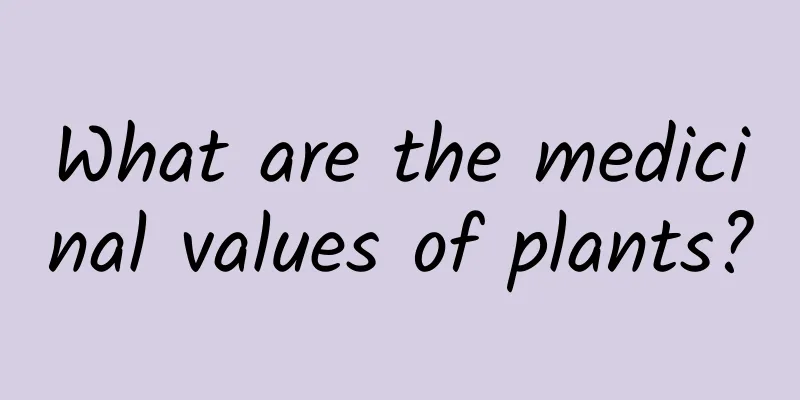What are the medicinal values of plants?

|
The most traditional treatment method of traditional Chinese medicine is to use Chinese medicine to regulate the body, but it is always ubiquitous in our lives, because many Chinese medicines have sufficient medicinal value. For example, wild vegetables and wild flowers beside the road may be common Chinese medicines. Are they a kind of Chinese medicine? What are the medicinal values? How to make plants into Chinese medicine? Plants used in medicine to prevent and treat diseases. All or part of the plant can be used for medicinal purposes or as raw materials in the pharmaceutical industry. In a broad sense, it can include plant resources used as nutrients, certain indulgences, seasonings, color additives, pesticides and veterinary drugs. There are many kinds of medicinal plants, and their medicinal parts are different. Some are all used as medicine, such as Leonurus japonicus, Prunella vulgaris, etc.; some are used as medicine, such as ginseng, Datura, Belamcanda chinensis, Platycodon grandiflorum, Rhodiola rosea, etc.; some need to be extracted before being used as medicine, such as quinine. In ancient China, Shennong's Herbal Classic classified medicines into three grades: superior, medium, and inferior according to their efficacy. In addition to continuing to use the three-category classification, "Shennong's Herbal Classic Annotations" also created a method of dividing the medicines into herbal, fruit, vegetable, and grain categories based on their properties. The Compendium of Materia Medica adopts the natural property classification method, dividing the collected medicines into 16 classes and 60 categories, and based on physiological and ecological conditions, divides the grass medicines into mountain grass, fragrant grass, marsh grass, poisonous grass, creeping grass, stone grass, moss, etc. This is the most complete classification system in ancient China. In medicine, drugs are generally classified according to their properties and pharmacological effects. Traditional Chinese medicine often divides drugs into categories such as antipyretic drugs, heat-clearing drugs, anti-rheumatic drugs, qi-regulating drugs, and tonic drugs according to their properties; modern medicine often divides drugs into categories such as sedatives, analgesics, cardiotonic drugs, and anti-cancer drugs according to their pharmacological effects. Medicinal botany can reflect the relationship of medicinal plants by classifying them according to plant systems, which is beneficial for the study of morphology, anatomy and composition. Chinese medicine identification and medicinal plant cultivation are often classified according to the medicinal parts, including roots, rhizomes, barks, leaves, flowers, fruits, seeds, whole herbs, etc., which facilitates the identification of medicinal characteristics and the understanding of their cultivation features. The chemical composition of plants is relatively complex. Some components are common to all plants, such as cellulose, protein, oil, starch, sugars, pigments, etc.; some components are unique only to certain plants, such as alkaloids, glycosides, volatile oils, organic acids, tannins, etc. Each type of chemical component has certain characteristics, and the appearance, color, smell, and taste of the medicinal materials can generally be used as one of the means of preliminary inspection and judgment. For example, if there are no oily spots on the cross section of the medicinal material after it is broken, or there are oil marks after squeezing, it mostly contains fat or volatile oil; those with a powdery layer mostly contain starch and sugar; those with a special smell mostly contain volatile oil, coumarin, and lactone; those with sweet taste mostly contain sugar; those with neutral taste mostly contain alkaloids, glycosides, and bitter substances; those with sour taste contain organic acids; those with astringent taste mostly contain tannins, etc. You should know that the medicinal value of plants is very wide. Although plants are of different types and styles, the medicinal value of plants is very wide. Various medicines made from plants can be used for correct diet therapy, which is also very helpful for regulating the body and enhancing physical health. |
<<: Is Cistanche deserticola the same as Cistanche deserticola?
>>: What are the medicinal values of plants?
Recommend
The reason why there are so many mosquitoes has been found. Does the virus attract mosquitoes by regulating skin bacteria to produce "mosquito attractants"?
Great scientific discovery! Mosquitoes can actual...
Report! You can wear short sleeves in the Arctic
Is there a feeling? In recent years, the winters ...
Cancer cells can be eliminated in as fast as 30 minutes! How amazing is this anti-cancer technology?
Expert in this article: Ning Bikang, Researcher, ...
Wetland Guardian, explore the magnificent transformation of the White Bone Peak!
This warm scene is a mother white-bone croaker fe...
Two women in Henan were poisoned after eating cold noodles. How toxic is the fumonisin that cannot be killed by high temperature? Be careful with these foods
According to media reports, on July 3, two women ...
The efficacy and function of fence net
Fence net is a medicinal material that can treat ...
This is the roundest object in the world, worth tens of millions, and its existence can change the world
Which object on Earth is closest to being a true ...
Tribulus terrestris
Tribulus terrestris is a relatively common wild h...
The efficacy and function of the thorny peduncle fern
The spiny pedunculate rosette fern is a kind of t...
The efficacy and function of red thread hemp
Red thread hemp is a medicinal material. If we ha...
Why is it said that the Jiangcun Tomb is the Mausoleum of Emperor Wen of Han?
On the morning of the 14th, the State Administrat...
Why can English become the only scientific language? |
In the 19th century, there were many languages ...
Exploring Eternity: Gödel and Einstein
Einstein has many intriguing quotes, such as he s...
When hot water and cold water are put into the refrigerator together, why does the hot water freeze first?
Image source: Pixabay In the hot summer, if you a...









